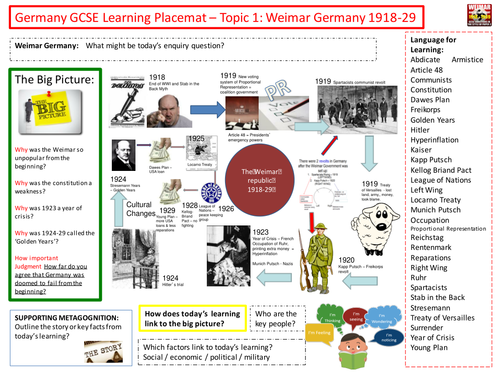
9-1 Edexcel History Learning/Topic Placemats for Weimar and Nazi Germany - Topic 1 -Weimar Germany 1918-29
These interactive learning placemats were designed to meet the challenges of the new 9-1 GCSE. They build upon the successful Medicine Through Time Placemats that I previously designed (and which received 5* reviews by all who have purchased them up to the time of launching these new materials – see: https://www.tes.com/teaching-resource/9-1-edexcel-gcse-history-of-medicine-place-mat-question-structure-11627611 ). The new placemats have been identified as best practice during a ‘Challenge Partners’ review as well as being identified as best practice by other History teachers on the Olevi ‘Outstanding Teacher Programme’.
The new design learning placemats support both teachers and students in addressing the:
a) dramatic increase in the curriculum content needed for the different units
b) support the need for increased literacy demands
c) help students become familiar and more confident in recognising the correct response needed for the unprecedented number of different question styles
The placemats are designed to be double sided. One side focuses on the CONTENT: providing an overview of key knowledge and understanding needed (this will change for each topic area within this GCSE unit).
Every placemat across the GCSE range is designed to encourage greater understanding of:
1. Historical Context - through timelines, picture prompts and key words
2. Awareness of the ‘big picture’ so students can see how individual lessons fit into the unit and make clearer links between prior and future learning – through ‘Big Picture’ questions.
3. Better Literacy – through selected ‘language for learning’ vocab box.
4. Memory prompts to support revision – through the use of carefully selected images.
5. Increased awareness of metacognition – through PME (Progress, Monitor and Evaluation Time) questions to encourage students to deconstruct their learning and identify key factors (eg. Social, economic, political) or key individuals and make links between features. A pictorial metacognition man with 5 question prompts will support student reflection.
6. A confidence thermometer is also included as a prompt to identify student confidence in the topic.
The reverse side contains guidance on EXAM TECHNIQUE through:
1. Identifying the nature of the question styles for each GCSE Unit and the allocated marks available
2. Examiners levelled mark schemes
3. Support writing frames with generic sentence starters
These interactive learning placemats were designed to meet the challenges of the new 9-1 GCSE. They build upon the successful Medicine Through Time Placemats that I previously designed (and which received 5* reviews by all who have purchased them up to the time of launching these new materials – see: https://www.tes.com/teaching-resource/9-1-edexcel-gcse-history-of-medicine-place-mat-question-structure-11627611 ). The new placemats have been identified as best practice during a ‘Challenge Partners’ review as well as being identified as best practice by other History teachers on the Olevi ‘Outstanding Teacher Programme’.
The new design learning placemats support both teachers and students in addressing the:
a) dramatic increase in the curriculum content needed for the different units
b) support the need for increased literacy demands
c) help students become familiar and more confident in recognising the correct response needed for the unprecedented number of different question styles
The placemats are designed to be double sided. One side focuses on the CONTENT: providing an overview of key knowledge and understanding needed (this will change for each topic area within this GCSE unit).
Every placemat across the GCSE range is designed to encourage greater understanding of:
1. Historical Context - through timelines, picture prompts and key words
2. Awareness of the ‘big picture’ so students can see how individual lessons fit into the unit and make clearer links between prior and future learning – through ‘Big Picture’ questions.
3. Better Literacy – through selected ‘language for learning’ vocab box.
4. Memory prompts to support revision – through the use of carefully selected images.
5. Increased awareness of metacognition – through PME (Progress, Monitor and Evaluation Time) questions to encourage students to deconstruct their learning and identify key factors (eg. Social, economic, political) or key individuals and make links between features. A pictorial metacognition man with 5 question prompts will support student reflection.
6. A confidence thermometer is also included as a prompt to identify student confidence in the topic.
The reverse side contains guidance on EXAM TECHNIQUE through:
1. Identifying the nature of the question styles for each GCSE Unit and the allocated marks available
2. Examiners levelled mark schemes
3. Support writing frames with generic sentence starters
Something went wrong, please try again later.
Report this resourceto let us know if it violates our terms and conditions.
Our customer service team will review your report and will be in touch.
£3.00
